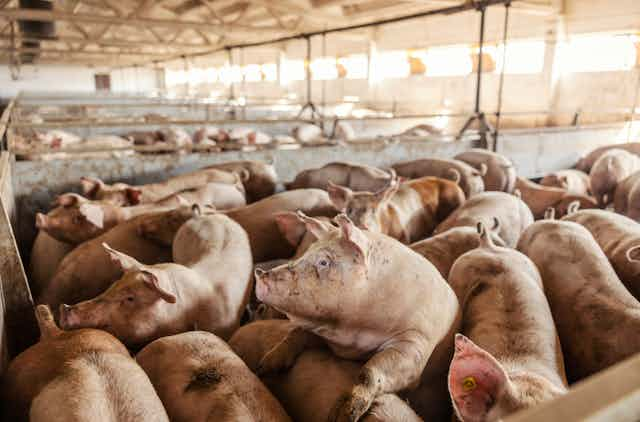A British man has contracted swine flu, the first detected human case recorded in the UK. Here’s what you need to know about the disease.
Why is swine flu currently in the news?
A new variant of the influenza virus has been identified in a man from North Yorkshire, following a routine flu screening test.
Flu or influenza is classified using two molecules on the surface of the virus: haemagglutinin (H, there are 18 subtypes) and neuraminidase (N, with 11 subtypes). The new virus is classed as H1N2 – a group previously rare in people and more often found in pigs.
It is not clear if the 2023 H1N2 virus has gained new characteristics that should concern us. Its genetic pattern shows some distinct features, but as the COVID pandemic showed us, viral genes change steadily over time.
Is it the same virus that caused the 2009 swine flu pandemic?
No. The 2023 virus differs considerably from the H1N1 that caused a pandemic in 2009. To protect us against H1N1, this variant has been included in many annual vaccine combinations offered in the UK since 2012.
Influenza viruses continually change their genes and surface molecules through processes known as “shift” and “drift”. They often cause outbreaks in autumn, but have the potential to cause global epidemics or pandemics when a novel virus evades human immune defences.
Historically, some influenza outbreaks have been “zoonotic”, spilling over from animals to humans when a shift or drift drives a change of host. Influenza can infect most birds, pigs, horses, whales, cats, dogs and seals, usually with specific HN types.
How dangerous is it?
The risks posed by the new H1N2 are unclear.
On the plus side, the infected man from North Yorkshire – the so-called “index case” – was not very unwell and did not need admission to a hospital. This suggests the virus is not a powerful pathogen.
It is reassuring, too, that in Yorkshire there have been no reports of unexplained illness in large numbers of children, elderly, pregnant people or those with compromised immune systems – or, indeed, farm animals, including pigs. So the index case does not appear to be part of a wider human or animal outbreak.
So how did he become infected if he had no contact with pigs? One possibility is that he is one of many infected with this virus. This is a troubling interpretation because it would suggest there has been an efficient spread of a new influenza virus among humans.
It is difficult to stop person-to-person viral spread, as the COVID pandemic showed us. This week and next, a range of careful and strategic screening checks will take place in various communities in Yorkshire to establish if others with mild respiratory illnesses, or perhaps no illness, are carrying this virus.
Such investigation will probably also involve pig herds, because pig wellbeing is an important component of this probable viral spillover from animals.
The alert raised by this positive finding shows the value of processing samples from GP surgeries. Such alerts, however, require considerable follow-up to address the potential dangers.

Is it different from regular flu?
Based on the information from the one case, this virus is just like several other influenza viruses that cause upper respiratory tract infections (coughs and colds) in people.
What are the symptoms?
Typical flu symptoms include a raised temperature, a cough, sore throat and nasal stuffiness, along with muscle pains, headache and fatigue. There may be some vomiting and diarrhoea, too, particularly in children.
A few patients may get a lung infection or even heart problems – but this is very rare. Other rare problems include brain swelling, sepsis and secondary bacterial infections.
How is it treated?
Recommended treatments for influenza-like symptoms include rest, drinking lots of fluids and drugs to control fever and pain. You should seek medical advice if any symptom becomes severe because influenza of any type can be fatal – although this is very rare.
Can I get it from eating pork?
There are no known cases of contracting influenza from eating pork.
Will wearing a mask and washing my hands protect me?
Both masks and handwashing reduce all the risks of contracting respiratory diseases for all of us wherever we live. These simple interventions are often overlooked, or not performed as well as they should be.
Who is most at risk?
As yet, we do not know who is most likely to contract the new H1N2 influenza. This information should become more clearly defined by the studies being carried out at present.
Is there a vaccine against it?
There is no vaccine against the new H1N2. Thankfully, however, global preparedness has never been so well attuned to the challenge of vaccine development.
A vaccine for a newly discovered virus variant can be made within months using existing technologies. Safety testing and regulatory processes will extend this, but the capabilities and collaborations are in place should they be required.
How serious a threat to public health is it?
No available evidence suggests this new virus is a risk to public health. However, some important elements of information about H1N2 are required, along with plans to contain any spread from the index case in Yorkshire.

